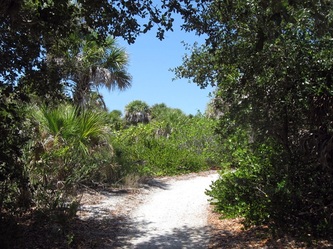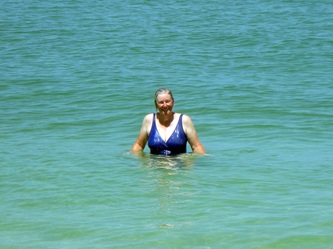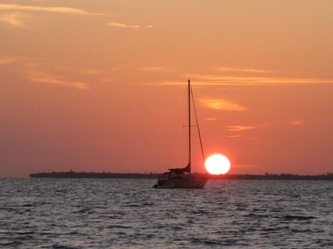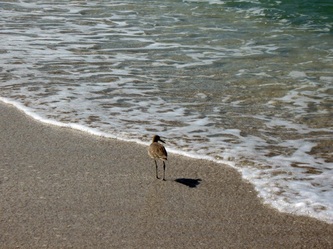
Cayo Costa State Park beach
The prevailing easterly winds had been blowing with force for over a week before they finally eased up, allowing for our departure from Marathon on Friday, the 16th, setting out for a trip up the west coast toward the Little Shark River on our way to Fort Myers Beach. Over the course of two weeks, we traveled up the west coast and spent time in new places, seeing a bit more of this new cruising ground.
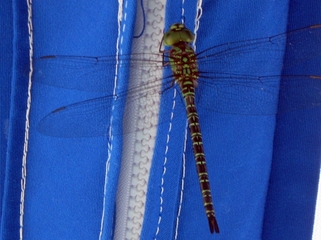
A stowaway joins us for the ride through the Everglades
Letting Go and Moving On
We were up before dawn our last morning in Marathon to check the weather and then make one last run to shore to return our shower cards, take in the trash and get our last jug of water. It would likely be several days before we could land again for services. As Cathy made her way back to the dinghy, she looked in confusion because it was gone. She walked the length of the dock looking for it. Nowhere. She waits and looks toward the mooring field for moving lights that might be Dave. Finally, she sees an odd procession of boats approaching – an inflatable, a portabote and a hard dinghy. It was obvious as they came closer that Dave was in the middle of this procession. Dave later explained that he had gone to rescue a woman in a dinghy that had run out of gas. In the dark, Dave had inadvertently pulled the kill switch out of the engine and therefore couldn’t restart the engine, requiring yet another boat to come to the rescue. A little excitement to start our day. We went back to the boat and headed out as the sun rose behind us.
Behind us the Keys were enjoying clear skies and puffy clouds. As we approached Cape Sable and the southwest corner of the Florida peninsula, we were looking at a little different weather picture. Ahead of us the line of dark clouds spilling off the mainland kept growing and, it became apparent, was not going to pass out to sea before we reached them. We were going to have to make our way through the storm before we could reach our refuge in the Little Shark River. We had enjoyed hours of motorsailing across the Florida Bay, but as the clouds got closer, we decided to furl in the sail and began to prepare ourselves for the deluge. About an hour out, it hit. We found ourselves in our first thunderstorm. We struggled to keep the bow into the waves as the wind slowed our progress to little over a knot. The rains poured down and lightning and thunder sounded around us. After about a half hour, it was over and the river entrance was off our port bow. We made our way in and set anchor, relieved to be in for the day.
The next day we headed out again, thinking we were going to Russell Pass for the night, retracing our stops from our trip south. However, we found we could use the wind if we aimed for Coon Key Pass just south of Goodland. We set the headsail and motorsailed for our new destination. If all went well, we should arrive by 6. However, we were making 5 knots, good speed for the little boat, and our arrival time came in to 5pm. As we made our way up the pass, we approached the no wake zone and throttled back on the engine, making our way to the anchorage a short distance away.
And then the engine promptly died.
We were up before dawn our last morning in Marathon to check the weather and then make one last run to shore to return our shower cards, take in the trash and get our last jug of water. It would likely be several days before we could land again for services. As Cathy made her way back to the dinghy, she looked in confusion because it was gone. She walked the length of the dock looking for it. Nowhere. She waits and looks toward the mooring field for moving lights that might be Dave. Finally, she sees an odd procession of boats approaching – an inflatable, a portabote and a hard dinghy. It was obvious as they came closer that Dave was in the middle of this procession. Dave later explained that he had gone to rescue a woman in a dinghy that had run out of gas. In the dark, Dave had inadvertently pulled the kill switch out of the engine and therefore couldn’t restart the engine, requiring yet another boat to come to the rescue. A little excitement to start our day. We went back to the boat and headed out as the sun rose behind us.
Behind us the Keys were enjoying clear skies and puffy clouds. As we approached Cape Sable and the southwest corner of the Florida peninsula, we were looking at a little different weather picture. Ahead of us the line of dark clouds spilling off the mainland kept growing and, it became apparent, was not going to pass out to sea before we reached them. We were going to have to make our way through the storm before we could reach our refuge in the Little Shark River. We had enjoyed hours of motorsailing across the Florida Bay, but as the clouds got closer, we decided to furl in the sail and began to prepare ourselves for the deluge. About an hour out, it hit. We found ourselves in our first thunderstorm. We struggled to keep the bow into the waves as the wind slowed our progress to little over a knot. The rains poured down and lightning and thunder sounded around us. After about a half hour, it was over and the river entrance was off our port bow. We made our way in and set anchor, relieved to be in for the day.
The next day we headed out again, thinking we were going to Russell Pass for the night, retracing our stops from our trip south. However, we found we could use the wind if we aimed for Coon Key Pass just south of Goodland. We set the headsail and motorsailed for our new destination. If all went well, we should arrive by 6. However, we were making 5 knots, good speed for the little boat, and our arrival time came in to 5pm. As we made our way up the pass, we approached the no wake zone and throttled back on the engine, making our way to the anchorage a short distance away.
And then the engine promptly died.
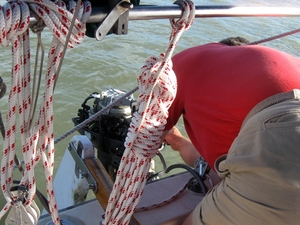
Dave labors over the outboard
After several attempts to restart it failed, Cathy turned it over to Dave who checked the fuel, the fuel filter and the lines to the engine, all of which looked good. He tried to start it with the pull cord as well as the electric start, but nothing worked. The boat was luckily drifting very little due to a fortunate mix of current and wind, but we finally decided we needed to drop the anchor, since we were at the edge of the channel, and turn our full attention to the engine. We were repeatedly thanking our lucky stars that we were behind the no wake signs, since west coast power boaters are famous for their wakes. Since it was approaching 5pm, we called the nearby marinas to see if they had mechanics available and if we had to be towed, whether we could stay there. Neither marina had any help to offer and their mechanics would not be back until Monday, which would be 2 expensive nights on the dock from now. As Dave continued to try other things with the engine, Cathy called Blake Hollings, the engine mechanic who had serviced our engines in Daytona. It was a long shot, but maybe he would call back.
Just as we were trying to decide if we could swap the dinghy motor for the big motor, the phone rang. It was Blake, and he didn’t hesitate to step Dave through a number of diagnostic steps to zero in on the problem. First he checked the spark plug to ensure it was sparking. He had to remove it from the engine, but leave it in the boot and touch it to metal while Cathy started the engine, looking for the spark. In the late afternoon sun, it took a couple of tries, but he managed to see the spark. No problem there.
That meant the problem was likely in the carburetor. Dave had to remove the cover which has 2 long bolts that hold not just the cover, but the carburetor itself. As Dave fitted the sockets on the handle, they slipped off and fell into the cockpit floor, behind the gas can and down the small thru-hull. (Isn’t that always the way on boats?) We switched to another socket and Dave managed to get the cover off without losing the bolts or the carburetor. Whew! At that point, Blake had us spray WD 40 into the butterfly valve as we attempted to start the engine on a higher throttle setting. After some effort, it starts with a roar and stays running. Alright! After shutting it down and restarting, it runs fine. We thank Blake profusely and would highly recommend him to anyone needing outboard repairs in the Daytona area. His phone number is 863-860-0145.
Now, we begin getting the engine back together to move on. Dave is still mulling over the lost tool, so he gets in the dinghy to position himself behind the thru hull, while Cathy pokes a wire down the hole to poke it out. Sure enough, it’s still in there and he manages to grab it. Things are definitely looking up.
Just as we were trying to decide if we could swap the dinghy motor for the big motor, the phone rang. It was Blake, and he didn’t hesitate to step Dave through a number of diagnostic steps to zero in on the problem. First he checked the spark plug to ensure it was sparking. He had to remove it from the engine, but leave it in the boot and touch it to metal while Cathy started the engine, looking for the spark. In the late afternoon sun, it took a couple of tries, but he managed to see the spark. No problem there.
That meant the problem was likely in the carburetor. Dave had to remove the cover which has 2 long bolts that hold not just the cover, but the carburetor itself. As Dave fitted the sockets on the handle, they slipped off and fell into the cockpit floor, behind the gas can and down the small thru-hull. (Isn’t that always the way on boats?) We switched to another socket and Dave managed to get the cover off without losing the bolts or the carburetor. Whew! At that point, Blake had us spray WD 40 into the butterfly valve as we attempted to start the engine on a higher throttle setting. After some effort, it starts with a roar and stays running. Alright! After shutting it down and restarting, it runs fine. We thank Blake profusely and would highly recommend him to anyone needing outboard repairs in the Daytona area. His phone number is 863-860-0145.
Now, we begin getting the engine back together to move on. Dave is still mulling over the lost tool, so he gets in the dinghy to position himself behind the thru hull, while Cathy pokes a wire down the hole to poke it out. Sure enough, it’s still in there and he manages to grab it. Things are definitely looking up.

Orion Jr at anchor at Goodland - - Finally!
We move the short distance to the anchorage, and by 6:30 we set anchor off Goodland. We are once again thankful to be in a good anchorage for the night. Although one more disturbing observation comes to mind as we settle in. Over the course of the hour while we worked on the engine, we were passed multiple times by boats small and large. And not one stopped to ask if we needed help. It’s definitely not Marathon.

Stan's -- home of the Buzzard Lope
Goodland
When we realized we were in Goodland for a Sunday, we decided to stay put for the day. There was supposed to be a quaint establishment called Stan’s that came to life on Sunday, when the owner performed in the afternoon. In our minds, we pictured a small place with a couple dozen patrons and an octogenarian singing some old songs and telling a few jokes on stage. Before we could go ashore, Ron from his nearby bright yellow trimaran, Chiquita, rowed over and gave us some tips on where to dock a dinghy and encouraged us to see the little town.
When we realized we were in Goodland for a Sunday, we decided to stay put for the day. There was supposed to be a quaint establishment called Stan’s that came to life on Sunday, when the owner performed in the afternoon. In our minds, we pictured a small place with a couple dozen patrons and an octogenarian singing some old songs and telling a few jokes on stage. Before we could go ashore, Ron from his nearby bright yellow trimaran, Chiquita, rowed over and gave us some tips on where to dock a dinghy and encouraged us to see the little town.
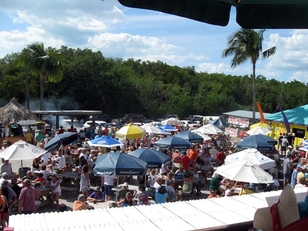
The Sunday crowd at Stan's
After making a stop at Walker’s Coon Key Marina for fuel and water, we head around to Stan’s. We can hear the band from a distance and begin to get a first inkling that Stan’s might be a little bigger than we thoughg. As we approach the far end of the canal, we are overwhelmed by the number of boats, several of which are rafted on the dock and the mass of humanity on shore. This is Stan’s. We give up trying to dock nearby and go back out to some slips by Marker 8 Restaurant. After checking with the owner that we can leave our dinghy there, we wander over to Stan’s. On the way the small street is lined with cars and roadside vendors selling their wares. Parking is going for $10. This is amazing. At Stan’s we see a live band that has the crowd rocking. We learn that Stan has gone home sick, but the party is not waning in the least. After taking in the spectacle (and buying some really fresh produce at the farm stand on site), we finally retreat back to the boat. This is a little too much. On the way back, we meet Adam from Igloo, whom we had first met in Marathon. He joins us later on Orion Jr for a glass of wine.
It was definitely good to see Goodland on a Sunday. But once was probably enough.
It was definitely good to see Goodland on a Sunday. But once was probably enough.
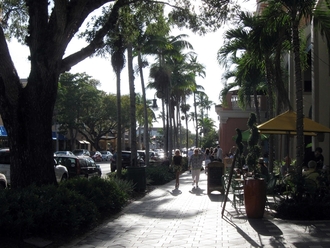
5th Avenue in Naples
Naples
As we moved north on Monday, we skipped Marco Island in favor of Naples, arriving mid-afternoon to pick up one of the city’s mooring balls. Although we took the inside route north, the closer we got to Naples, the thicker the power boats got and the more intense the boat wakes. Passing the Gordon Pass inlet the intensity of wakes hit a new threshold. Boat after boat passed on either side, sending Jr careening side to side. With relief, we passed the no wake zone sign as the mooring field came into sight. Naples policy requires us to tie up to the fuel dock to “get a pump out” (which we explained wasn’t necessary) and to register for a mooring ball. The policy also says that we can stay at most 4 consecutive nights on the ball and 8 in a month. This is a state-imposed “punishment” that this city is required to follow due to some violations in the past, where boats were allowed to stay too long. At any rate, we had only one other neighbor in the mooring field and were on the closest ball to the dinghy dock.
.
As we moved north on Monday, we skipped Marco Island in favor of Naples, arriving mid-afternoon to pick up one of the city’s mooring balls. Although we took the inside route north, the closer we got to Naples, the thicker the power boats got and the more intense the boat wakes. Passing the Gordon Pass inlet the intensity of wakes hit a new threshold. Boat after boat passed on either side, sending Jr careening side to side. With relief, we passed the no wake zone sign as the mooring field came into sight. Naples policy requires us to tie up to the fuel dock to “get a pump out” (which we explained wasn’t necessary) and to register for a mooring ball. The policy also says that we can stay at most 4 consecutive nights on the ball and 8 in a month. This is a state-imposed “punishment” that this city is required to follow due to some violations in the past, where boats were allowed to stay too long. At any rate, we had only one other neighbor in the mooring field and were on the closest ball to the dinghy dock.
.
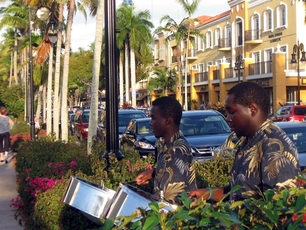
Musicians play on the street in Naples
On shore, the Naples City Dock is a short walk to a small business district. We wandered into town, checked out the nearby marine supply store and then took a longer walk past the park and down trendy 5th Avenue. Dave was excited to find only the 2nd Abbotts Frozen Custard store we had seen outside of Rochester, so he had to do some quality control tasting. Then we stopped into a restaurant for some wine and live music, with free hor d’ouvres to boot. On the way back to the boat, we passed by a Jazz in the Park concert, which we enjoyed for a while until we decided to call it a day.
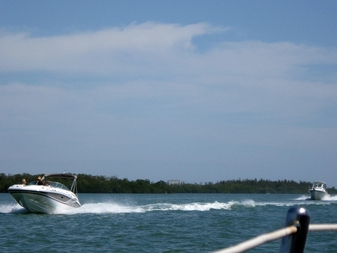
Power boats galore on the waterway
Over the next 3 days, we did a lot of walking the tree-lined streets -- to the beach, by the shops across the bridge to the grocery store and West Marine and back again. One day we rode the bus all over town. We swam in the gulf and enjoyed some time getting boat chores done (like sealing some leaking portlights and deckfittings). On Thursday night, there was live music up and down 5th Avenue. By the time our 4 days were up, we were considering staying longer, but the weather forecast told us we should probably move on. So, on Friday, we made our way out of the mooring field at first light, hoping to avoid the worst of the power boats on our way out Gordon Pass. We were largely successful, but still it was with a sense of relief that we pulled out into the Gulf and close quarters were behind us. But Naples itself will probably draw us back for another visit.

Driftwood on Cayo Costa beach
Cayo Costa
After a brief stay in Fort Myers Beach, we headed north for Pelican Bay off Cayo Costa, a beautiful state park just south of Boca Grande. We had heard several cruisers talk about this lovely spot, so we were anxious to see it for ourselves. After another tedious run with boat wakes everywhere, we pulled into the protected bay and set the anchor. We made a quick run to shore to get the lay of the land, but decided to save our more serious exploring for the next day.
After a brief stay in Fort Myers Beach, we headed north for Pelican Bay off Cayo Costa, a beautiful state park just south of Boca Grande. We had heard several cruisers talk about this lovely spot, so we were anxious to see it for ourselves. After another tedious run with boat wakes everywhere, we pulled into the protected bay and set the anchor. We made a quick run to shore to get the lay of the land, but decided to save our more serious exploring for the next day.
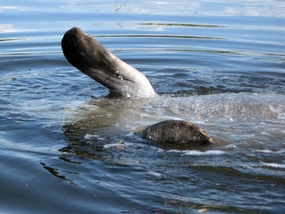
The park has about 10 slips which are free for the day, but cost $20 to stay the night. So, we decided to stay anchored. For a $2 park fee, the facilities ashore were ours to enjoy. We took the tram to the beach, went shelling, swam every day in the Gulf and hiked miles of trails around the island. We saw more wildlife here than anywhere in the Everglades, from a family of manatees in a nearby cove, an alligator in the lagoon, a wide variety of wading birds and shore birds and even a 6 foot long (non-poisonous) coach whip snake. We visited with other boaters in the harbor and some of the campers on shore. We were even able to arrange with another boat to pick up some gas for us in Boca Grande when they took a side trip for lunch one day. We could take showers off the beach in the campground area and have a picnic lunch at tables in a pavilion there. We could have stayed longer, but we needed to start making our way back. Once again we left on a Friday at first light and manage to beat the power boaters for a few hours, arriving in Fort Myers Beach in mid-afternoon for our last stop on the west coast before heading inland.

Fort Myers Beach
This has become our hub for travel on the Florida’s west coast. We managed to arrive just in time for a Cruiser’s Appreciation lunch with food and raffled off prizes and started making a walk and swim on the beach our daily routine. With college Spring Break in one last burst of energy on our first stop here, we watched in amazement as the crowds thronged the beach and dozens of boats anchored in the surf just off shore, creating a horribly fascinating show as some struggled to keep their boats under control and out of the surf and other boats. The trolley gave us easy access to groceries and the facilities here are comfortable and convenient. But the season is winding down, as is evidenced by the increasing number of mooring balls available, and so we will be leaving here soon ourselves, making our way up to LaBelle.
This has become our hub for travel on the Florida’s west coast. We managed to arrive just in time for a Cruiser’s Appreciation lunch with food and raffled off prizes and started making a walk and swim on the beach our daily routine. With college Spring Break in one last burst of energy on our first stop here, we watched in amazement as the crowds thronged the beach and dozens of boats anchored in the surf just off shore, creating a horribly fascinating show as some struggled to keep their boats under control and out of the surf and other boats. The trolley gave us easy access to groceries and the facilities here are comfortable and convenient. But the season is winding down, as is evidenced by the increasing number of mooring balls available, and so we will be leaving here soon ourselves, making our way up to LaBelle.
